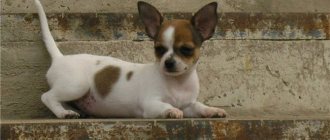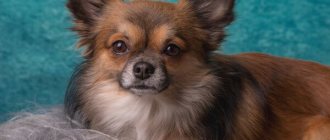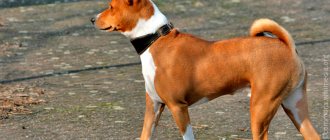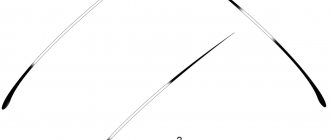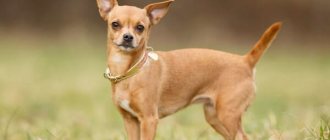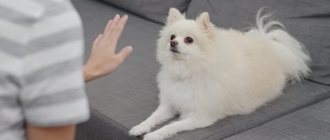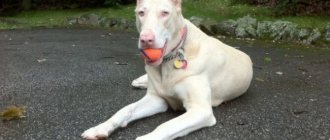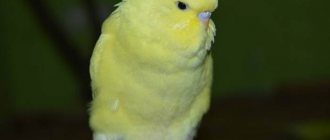A pleasant feature of the Chihuahua is that dogs of this breed amaze with their variety of coat colors. Probably, no breed has such a rich color palette as the Chihuahua, which guarantees the uniqueness and originality of each individual individual. RKF (Russian Cynological Federation) has more than 90 color variations and combinations. I would like to note that the RKF recognizes any colors of Chihuahuas, both long-haired and short-haired. However, there is one exception. The color recognized as such an exception is Merle (aka Marble). It is officially banned not only by the RKF, but also by the International Association of Cynological Federations (or FCI) for a number of reasons.
This does not mean at all that a similar color of a Chihuahua cannot be found on the territory of the Russian Federation, and purchasing a puppy with a merle coloring will be a crime. No! But be prepared for a legal refusal to participate in various specialty shows, and to join the National Breed Club (NKC), if this is part of your plans. In addition, there may be a number of congenital problems with the physical and psychological health of the dog even in puppyhood. However, experienced breeders work hard to produce healthy offspring of merle puppies in order to prove that they cannot be considered outcasts and defective. There are also active debates on this topic on various thematic forums.
You have already understood that it is extremely important to navigate the existing colors in order to purchase a healthy, beautiful and problem-free puppy, or to exclude the appearance of a litter with a coat color that is not recognized by the RKF at the crossbreeding stage. Remember that it is the puppy’s color palette that directly affects its final cost, in addition to excellent health. For example, sable color is considered less valuable than chocolate color. Experienced breeders understand this very well and carefully select a pair for crossing in order to produce a litter of the most valuable and rare colors. Naturally, conscientious breeders pursue not only material gain, but also try to produce, among other things, healthy offspring. But Mother Nature has the last word. If you are planning to buy a Chihuahua dog, I recommend that you find in advance a bona fide breeder who professionally breeds puppies with the specific color you need.
So, below are presented to your attention various types of markings, and existing popular and rare colors of Chihuahuas with photos. All these colors are found in both long-haired and short-haired individuals. It is important to understand that marking is a kind of color combination that gives one or another pattern on the dog’s coat:
- Pure color (or monotonous). The color of the coat does not matter; it can be either solid white or brown, chocolate, or black. Small white spots on the chest or toes are acceptable. However, the main color must occupy at least 95% of the dog's total coat area.
- Two-tone color (or spotted). This colorway includes two different solid colors. This color variation may include the following color combinations: black with white, chocolate with white, white with brown (or red), black with red, and so on. Moreover, the main color can occupy a large surface area of the wool, or be evenly distributed in combination with another color.
- Tricolor . A dog's coat is covered in 3 colors, with the third often being some shade close to the primary or secondary, the so-called tan. But there is also a clearly expressed flavor. The most common color of a Chihuahua of this marking is black and white with tan, but there are other exotic variations. For example, chocolate and tan with white.
When determining the color of a Chihuahua, the color of the nose, ears, pads and tips of the paws, eyelids, eyes, claws, and the distribution of pigment along the entire length of the hair are of considerable importance. In most cases, the background color of the dog's coat is white. Naturally, we will not consider all color variations (and there are more than 90 of them) because... It’s not difficult for even a professional to get confused in them, but let’s take a look at the most presentable, rare and popular ones.
Brief history of origin
The Chihuahua is considered an exquisite breed, the virtues of which every owner will appreciate.
In the 15th century BC, the first black individuals, called techichi, were found in Mexico. They were bred by the Toltecs and held the title of sacred animal. In the 17th century AD, Aztec tribes came to Mexico and ousted the Toltecs, but the Techichi did not lose their status. However, this can hardly be called an achievement, because they were often brought as a sacrifice to the gods or, in the event of the death of the owner, they were buried with him in the same grave.
After Mesoamerica was conquered by the Spaniards, the animals were in danger; they began to be destroyed during the destruction of Indian temples. However, several pets were able to escape into the forests, where they lived for centuries. During this time, Techichi, being in the forests, interbred with their relatives, and possibly with other wild animals. At the beginning of the 19th century, when they were caught and domesticated by local residents, they were no longer Techichi, but a completely different breed.
The first mentions of the breed appeared before our era, so it is classified as ancient
Among the pets that were bred, there were those that were black in color. It was they who became the ancestors of all black chixyaxya.
Officially accepted Chihuahua breed standards
The black Chihuahua, except for the shade, is no different from representatives of the breed of other colors. There is an officially recognized breed standard:
- The skull is round, there is no fontanel, but according to the standard, a slight depression is allowed.
- The nose is upturned and of short length. The lobe is traditionally black, but another shade is acceptable.
- The muzzle is short, tapering towards the nose.
- The eyes are large and round.
- The ears are triangular in shape and wide open.
- Straight or scissor bite.
- The neck is curved at the top. The short length is a disadvantage.
- The chest is wide and deep, the ribs are smoothly rounded.
- The tail is of medium length, curved towards the loin and set high.
- The front legs are straight, the hind legs are well muscled.
Important! The length of an animal's body is always greater than its height.
Based on coat type, the following types of Chihuahuas are recognized:
- Smooth-haired. The coat is short, smooth, and may or may not have an undercoat. The white smooth-haired Chihuahua is often found.
- Shorthair. Is an unacceptable coat type.
- Long-haired. The coat is thin, slightly wavy or straight, and can sometimes be fluffy. Near the ears it forms waves reminiscent of fringe.
The breed standard is officially approved, and individuals must comply with it
Varieties according to body shape
The varieties of Chihuahua that are bred on the basis of this breed are not recognized by any cynological organization in the world. The names of additional types of chia are not indicated in official documentation, but are used by amateurs and professional breeders.
Marketers argue that the distribution of additional species can only affect the final cost of the puppies.
Any deviation from the norm indicates the presence of congenital or acquired pathologies, genetic diseases, incorrect crossing, or closely related matings in babies. Sometimes unscrupulous breeders forget what Chihuahuas are like, because, trying to get the maximum benefit, they cross them with other dwarf dogs.
Cobby
This word translated from English means “strong, stocky.” Representatives of this species are characterized by distinctive features that can significantly affect their content:
- the body section is strong;
- the chest is wide;
- enlarged skull located on a small neck;
- ears are small but wide at the bottom;
- large round eyes, without signs of bulging;
- small muzzle;
- toned stomach;
- muscular paws;
- thick coat with thick undercoat;
- sickle-shaped thick tail.
The dogs are characterized by a confident gait with energetic kicks and a calm temperament without the slightest signs of aggression. Cobbies with long and short hair have many fans and are a valuable type because they attract attention with their classic appearance.
Dir
This body type is called a “deer”; representatives of the Dir are characterized by sophistication and sophistication. They have a small but narrow head and high-set ears. The dog has practically no wide parts, it is not powerful and far from muscular.
The limbs of this type are thin, elongated and less muscular than those of its previous brother. The animal is distinguished by a thin tail that does not touch its body. The baby runs easily, smoothly, there is no force in his movements.
Main types of colors
No other breed can boast such a variety of shades. According to the accepted standard, single-color, two-color colors and even tricolor Chihuahuas are allowed.
The main colors are the following:
- Ginger. An animal with a pure red coat tone is a rare specimen. Much more often this color is diluted with white spots on the chest, resembling a tie, on the muzzle and paws. Colors ranging from light red to brick are acceptable.
- Black. Representatives of this breed with a completely black color are not often found. Sometimes the tan is dark with small white inserts in the sternum area. The most popular color is black and tan with milky accents on the chest and legs. The black and white Chihuahua looks attractive.
- Chocolate. In a chocolate-colored Chihuahua, beige patches are allowed on the limbs and sternum, but the paw pads and tip of the nose must be chocolate in color. There is also a tricolor: a white body, with small dark spots and a brick-colored cape.
- Cream. Pets of this shade look very gentle. The intensity of the tone varies - from ivory to light beige.
Character traits
Despite their miniature size, these animals are distinguished by their stable psyche and high intelligence. They are not characterized by such traits as hysteria or cowardice. They are very proud, curious and arrogant.
Among other things, black and tan Chihuahuas, like other representatives of this breed, are very touchy. They cannot stand it when people communicate with them in a raised voice. Nevertheless, they will always meet the owner halfway to resolve a conflict situation.
These are very active temperamental creatures who are not shy about expressing their emotions. They are very loyal to their owners and do not tolerate stress very well. Due to their sociability, Chihuahuas get along well with children. But playing with them is fraught with injury for a small dog. Therefore, representatives of this breed need to avoid communicating with children.
Popular and recognized colors
Among the variety of colors, there are those that are in great demand, namely:
- white;
- sable;
- chocolate;
- black;
- gray-blue;
- wolfish;
- brindle;
- ginger;
- cream.
Important! In animals of cream or fawn color, darkening on the face, which is called a mask, is acceptable. Its size ranges from a slight blackening at the nose to a mask that can reach the level of the forehead.
Splotches on a Chihuahua's coat are not a sign of a defect.
Rare colors of Chihuahua
Despite the wide color palette of coat colors, there are also rare Chihuahua colors that are standard:
- White. With this type of coat color, the presence of any inclusions of a different color is unacceptable. The white Chihuahua has pink skin and a dark nose and claws. Sometimes the color serves as a background for other tones; for example, a white Chihuahua in combination with a black color looks especially attractive.
- Lilac. The lilac color of the Chihuahua is not so common. Sometimes puppies are born with a pinkish coat tone, which is called "Isabella". According to the standard, inclusions of white color are allowed in any part of the body, but not on the back and sides.
- Blue. Acceptable colors are smoky and rich gray. There are blue Chihuahuas with milky inserts in the chest and paws.
- Brindle. This color option has many gradations. The tiger palette includes both black, fawn and light shades. There are animals in which the milky shade is generously diluted with tiger spots.
Important! Pets with rare coat colors are more expensive than standard ones.
The pure black Chihuahua is a rare species and not easy to find.
Rules of care
For a smooth-haired black Chihuahua, brushing 2 or 3 times a week is sufficient. For long-haired individuals, daily combing with a comb is recommended.
There is no need to bathe Chihuahuas often, as these dogs get cold easily.
Your pet's eyes, ears, and teeth should be examined daily and cleaned as needed. To slow down the formation of plaque in your dog, you can let him chew on a toy or treat purchased at a pet store.
Nails are trimmed as needed using a nail clipper.
NOTE!
In the summer, before going for a walk, these dogs must be dressed in a light, light suit and a white or light-colored headdress placed on the pet’s head.
You can't do without clothes even in rain or cold weather. A black Chihuahua must have at least two overalls. One is made of waterproof fabric, for autumn, and the other is insulated, for winter.
Pros and cons of custom dogs
The advantages of non-standard pets are:
- Elegant appearance.
- Loyalty and devotion.
- There is no need to provide a large area for living.
- Relieve natural needs in a tray or diaper if walking is not possible.
- Devotion to the owner.
- High ability to train.
- Long lifespan, with proper care Chihuahuas can live up to 18 years.
- Predisposition to be a companion when attending social events.
The disadvantages are as follows:
- They prefer to choose only one owner.
- They get along poorly in families where there are children under 11-12 years old, because they are jealous of their owner and are not ready to share his attention with anyone.
- Requires careful handling due to small dimensions.
- They have a cocky disposition, so it is important for the owner to stop the dog’s bad behavior from puppyhood.
Important! Representatives of this breed need proper training, otherwise they can grow aggressive and even biting. If the owner cannot raise the dog on his own, it is best to seek the services of a specialist.
Chihuahua needs proper training
Walks
Some inexperienced owners mistakenly believe that sneezes do not need to be taken outside. In fact, despite their smaller size, these active dogs need regular walks. This will give them the opportunity for full emotional and physical development.
White, chocolate, blue and black and tan Chihuahuas can walk at air temperatures not lower than -10 and not higher than +30 degrees. Otherwise, the animal is at risk of frostbite or heatstroke. You need to gradually accustom your animal to the street. For your first walks, it is recommended to choose quiet places away from cars and large crowds of people. It is important that your pet is not afraid of anything. After all, a feeling of fear can create serious problems and prevent further acquaintance with the outside world.
Over the course of several weeks, the duration of walks should not exceed twenty minutes. During a walk, it is important to prevent your pet from getting wet or freezing. He also needs to be protected from communication with larger relatives, who could inadvertently injure the tiny dog. In public places it is better to keep your pet on a leash. Because passers-by may simply not notice it and accidentally crush it. If you encounter obstacles on your way, such as deep puddles, steep climbs or steps, you need to pick up the sneeze in your arms and move it from place to place.
Prohibited color
Despite the variety of shades of wool, there is a color that falls under categorical rejection. This color is merle, also known as merle.
Animals with this color palette of coats have coats that are unevenly colored gray or beige, which is why the marbled effect occurs, which is why the gray Chihuahua is a prohibited species. The eye color of these dogs is dull blue.
Important! For the first time, a dog of this color appeared in the 90s in a US kennel. The gene showed itself to be dominant. It is believed that the Chihuahua acquired it from another breed as a result of accidental mating, and not an error during breeding.
Merle coat color for Chihuahuas is a sign of marriage
What color affects the health of puppies
The merle color has a negative impact on the dog's health. Despite its visual appeal, it is prohibited by the Russian Canine Federation. This prohibition applies only to the Chihuahua breed.
Puppies with a merle-colored coat have poor health and are born with congenital hearing and vision problems. There have been cases of puppies being born that were missing ears and eyes, due to bad genes.
Important! In 2008, the decision was made to stop breeding merle puppies. However, it is worth noting that other merle-colored breeds are not included in the list of prohibited breeds.
Does color change with age?
Most often, black Chihuahuas do not fade and retain their coat color. The exception is those cases when a black Chihuahua puppy was born, but later its coat became sable in color. This tendency can be determined before purchase, since such puppies are not born with a black color, but rather a brownish one.
Important! You can determine the color of a dog by its nose - if it is brown, then the dog is chocolate. True black dogs have a nose that is always black, which eliminates mistakes when choosing.
A pet can live for many years with proper care and good attitude.
"TANYA'S HOUSE" breeding nursery RKF
ATTENTION!!!! PHOTOS OF ALL PUPPIES AND DOGS ARE TAKEN FROM THE INTERNET!!!
If any of the owners are against placing their dogs (puppies) in the table - WRITE. Photos will be taken upon request.
| Colors | Abbreviations | A comment | |
| Russian | English | ||
| White | |||
| White | white | white | All white dog |
| Black | |||
| Black | black | black | A completely black dog or black with a small white spot on the chest and possibly white paw tips |
| Black with white markings | black with white Elevation | black & white mark | A black dog with well-defined white markings on the chest, paws and possibly on the head, tip of the tail, and withers. |
| White black | White black | black-wh | White dog with black spots on head and body |
| White-black with specks | white-black with specks | black-wh& | A white dog with black spots on the head and body and numerous small black specks on a white background. |
| Chocolate | |||
| Chocolate | chocolate | chocolate | A completely chocolate dog or chocolate with a small white spot on the chest and possibly white paw tips |
| Chocolate with white markings | shock., with white Elevation | choc & wh mark | A chocolate-colored dog with well-defined white markings on the chest, paws and possible on the head, tip of the tail, and withers. |
| White chocolate | white-shock. | wh-choc | White dog with chocolate spots on head and body. |
| White-chocolate with specks | white-shock. with specks | wh-choc& | White dog with chocolate spots on the head and body and numerous small chocolate specks on a white background. |
| Blue | |||
| Blue | blue | blue | An all blue dog or blue with a small white spot on the chest and possibly white paw tips |
| Blue with white markings | blue with white Elevation | blue & wh mark | A blue dog with well-defined white markings on the chest, paws and possible on the head, tip of the tail, and withers |
| White-blue | white-blue | wh-blue | A white dog with blue spots on the head and/or body. |
| White-blue with specks | white-headed with specks | wh-blue | A white dog with blue spots on the head and/or body and numerous small blue specks on a white background. |
| Lilac | |||
| Lilac | lilac | lavender | |
| Lilac with white markings | lilac with white Elevation | lav & wh mark | A lilac-colored dog with well-defined white markings on the chest, paws and possible on the head, tip of the tail, and withers |
| White-purple | white-lilac | wh-lav | A white dog with purple spots on the head and/or body. |
| White-lilac with specks | white and purple. with white Elevation | wh-lav & | A white dog with lilac spots on the head and/or body and numerous small lilac specks on a white background. |
| Sable | |||
| Sable (Sable) Fawn with black tips of hair on the head, shoulders, along the back, tail | sable | sable | An all sable dog or a sable dog with a small white spot on the chest and possibly white paw tips |
| Sable with white markings | sable with white Elevation | sable & wh mark | A sable-colored dog with well-defined white markings on the chest, paws and possible on the head, tip of the tail, and withers |
| White and sable | white-sable | wh-sable | A white dog with sable spots on the head and/or body. |
| Red Sable Red with black tips of hair on the head, shoulders, along the back, tail | red sable | red sable | A completely red and sable dog or a red sable with a small white spot on the chest and possibly white paw tips |
| Red sable with white markings | red sable with white Elevation | red sable & wh mark | A red-sable dog with well-defined white markings on the chest, paws and possible on the head, tip of the tail, and withers |
| White-red sable | white and red sable | wh – red sable | A white dog with red-sable spots on the head and/or body. |
| Chocolate sable Fawn with brown tips of hair on the head, shoulders, along the back, tail | shock. sable | choc sable | A completely chocolate and sable dog or a chocolate and sable dog with a small white spot on the chest and possibly white paw tips |
| Chocolate sable with white markings | shock. sable with white elevation | choc. sable & wh. mark | A chocolate-sable dog with well-defined white markings on the chest, paws and possible on the head, tip of the tail, and withers. |
| White-chocolate sable | white-shock. sable | wh-choc. sable | White dog with chocolate and sable spots on the head and/or body. |
| Chocolate red sable Red with brown tips of hair on the head, shoulders, along the back, tail | shock. red sable | choc. red sable | A completely chocolate red sable dog or a chocolate red sable dog with a small white spot on the chest and possibly white paw tips |
| Chocolate red sable with white markings | shock. red sable with white Elevation | choc. red sable & wh mark | A dog of chocolate red-sable color with well-defined white markings on the chest, paws and possible on the head, tip of the tail, withers |
| White-chocolate red sable | white-shock. red sable | wh-choc. red sable | A white dog with chocolate red-sable spots on the head and/or body. |
| Redheads | |||
| Ginger | ginger | red | A completely red dog (all shades from light tan to red) or a red dog with a small white spot on the chest and possibly white paw tips |
| Red with white markings | red, white Elevation | red & wh mark | A red-colored dog with well-defined white markings on the chest, paws and possible on the head, tip of the tail, and withers |
| White-red | white-red | wh-red | A white dog with red spots on the head and/or body. |
| White-red with specks | white and red with specks | wh-red & | A white dog with red spots on the head and/or body and numerous small red specks on a white background. |
| Fawn | |||
| Pale yellow | pale yellow | fawn | A completely fawn dog or a fawn with a small white spot on the chest and possibly white paw tips |
| Fawn with white markings | fawn with white markings | fawn & wh mark | A fawn-colored dog with well-defined white markings on the chest, paws and possible on the head, tip of the tail, and withers |
| White-fawn | White-palmed | wh-fawn | A white dog with fawn spots on the head and/or body. |
| Blue-fawn | |||
| Blue-fawn | Goal-fall | blue-fawn | An all blue and fawn dog or a blue and fawn dog with a small white spot on the chest and possibly white paw tips |
| Blue-fawn with white markings | goal-scored with white Elevation | blue-fawn & wh mark | A dog of blue-fawn color with well-defined white markings on the chest, paws and possible on the head, tip of the tail, and withers |
| White-blue-fawn | white-goal-fire | wh-blue-fawn | A white dog with blue-fawn spots on the head and/or body. |
| Cream | |||
| Cream | cream | Cream | A completely cream dog or cream with a small white spot on the chest and possibly white paw tips |
| Cream with white markings | cream with white elevation | cream & wh mark | A cream-colored dog with well-defined white markings on the head, chest, paws and possible on the tip of the tail, withers |
| White-cream | white-cream | wh-cream | A white dog with cream spots on the head and/or body. |
| Tan | |||
| black | |||
| Black and Tan | h-p | bl&tan | A completely black and tan dog or black and tan with a small white spot on the chest and possibly white paw tips |
| Black and tan with white markings | h-p with white elevation | bl & tan, wh mark | The dog is black and tan with well-defined white markings on the head, chest, paws and possible on the tip of the tail, withers |
| Tricolor (Tricolor) | tricolor | tricolor | Black and tan color in combination with white, with white being the main color (more than 50%) |
| Tricolor (Tricolor) with specks | tricolor | tricolor | Black and tan color in combination with white, with white being the main color (more than 50%). On a white background there are numerous specks of black on the upper part of the body and red in places of tan |
| chocolate | |||
| Chocolate and tan | shock-p | choc & tan | A completely chocolate and tan dog or a chocolate and tan with a small white spot on the chest and possibly white paw tips. |
| Chocolate tan with white markings | shock-p with white mark | choc & wh mark | A chocolate-tan dog with well-defined white markings on the chest, paws and possible on the head, tip of the tail, and withers. |
| Chocolate tricolor | shock. tricolor | choc tricolor | Chocolate and tan color in combination with white, with white being the main color (more than 50%) |
| Chocolate tricolor with specks | shock. tricolor with specks | choc tr& | Chocolate and tan color in combination with white, with white being the main color (more than 50%). On a white background there are numerous specks of chocolate color on the top |
| blue | |||
| Blue and tan | Mr. | A completely blue and tan dog or blue and tan with a small white patch on the chest and possibly white paw tips. | |
| Blue and tan with white markings | g-p with white mark | A blue and tan dog with well-defined white markings on the chest, paws and possible on the head, tip of the tail, and withers. | |
| Blue tricolor | goal tricolor | Blue and tan color in combination with white, with white being the main color (more than 50%) | |
| Blue tricolor with specks | goal trick with specks | Blue and tan color in combination with white, with white being the main color (more than 50%). On a white background there are numerous specks of blue on the upper part of the body and red in the tan areas. | |
| purple | |||
| Lilac and tan | lil-p | lav-tan | A completely lilac and tan dog or lilac and tan with a small white spot on the chest and possibly white paw tips |
| Lilac and tan with white markings | lil-p with white mark | lav-tan&wh mark | A lilac-tan dog with white markings on the chest, paws and possible on the head, tip of the tail, and withers. |
| Lilac tricolor | Lilac tricolor | lav tricolor | Lilac and tan color in combination with white, with white being the main color (more than 50%) |
| Lilac tricolor with specks | lil tricolor with specks | lav tric& | Lilac and tan color in combination with white, with white being the main color (more than 50%). On a white background there are numerous specks of lilac on the upper part of the body and red in places of tan |
| brindle | |||
| Brindle Dog with alternating fawn (red) and black stripes on the body. Color can vary from almost black with a small number of fawn (red) touches to fawn (red) with a small number of black touches | brindle | brindle | Full brindle dog or brindle with a small white spot on the chest and possibly white paw tips |
| Brindle with white markings | Tiger. with white mark | brindle&wh mark | A brindle-colored dog with well-defined white markings on the chest, paws and possible on the head, tip of the tail, and withers |
| White and brindle | white tiger | wh&brindle | White dog with brindle spots on the head and/or body |
| Chocolate brindle Dog with alternating fawn (red) and brown stripes on the body. Color can vary from almost brown with some fawn (red) streaks to fawn (red) with some brown streaks | shock tiger | choc-brindle | Full chocolate brindle dog or chocolate brindle with a small white spot on the chest and possibly white paw tips |
| Chocolate brindle with white markings | shock tiger. with white mark | choc-brindle&wh mark | A chocolate brindle dog with well-defined white markings on the chest, paws and possible on the head, tip of the tail, and withers. |
| White-chocolate-brindle | white-shock-tiger | white-shock-tiger | White dog with chocolate brindle spots on head and/or body |
| Blue brindle A dog with alternating fawn (red) and blue stripes on the body. The color can vary from almost blue with a small amount of fawn (red) touches to fawn (red) with a small amount of blue touches. | goal-tiger | blue-brindle | An all blue brindle dog or a blue brindle with a small white patch on the chest and possibly white paw tips. |
| Blue brindle with white markings | goal-tiger with white mark | blue-brindle&wh mark | A dog of blue brindle color with well-defined white markings on the chest, paws and possible on the tip of the tail, withers |
| White-blue-brindle | white-gol-tiger | wh-blue-brindle | A white dog with blue brindle spots on the head and/or body. |
How to choose a future pet
Choosing a puppy begins with selecting a kennel with a good reputation, where the purchase should take place. It is best to read reviews of the shelter and talk to people who have used it, as this will give you a definite impression.
Useful tips for choosing Chihuahua puppies:
- When starting to choose, you should not give in to the temptation and take the puppy that you like best based on its color and eye color. Initially, you need to pay attention to his state of health and purebred. There is no need to choose pets with discharge from the eyes, an unpleasant odor from the mouth, traces of alopecia and unkempt fur.
- It is also better to avoid overly melancholic and cowardly animals, especially if it is an adult dog. It is best to give preference to the pet that was the first to go to the meeting.
- Buying a mixed breed in order to save money is also not the best idea. The overwhelming percentage of such dogs have congenital pathologies, and they are also characterized by unstable psyche.
- When choosing, the gender of the pet also plays an important role. Chihuahua girls are more capricious, while boys, on the contrary, are obedient. Girls, unlike boys, mark their territory less, which is an undeniable advantage.
- You should also pay attention to the weight of your pet. A puppy at the age of 3 months should not weigh less than 0.5 kg and more than 2.7 kg.
Important! Having decided on a specific pet, you should check whether the breeder has documents for it. Documents on vaccinations performed are also subject to verification.
It is important to be responsible when choosing a puppy so as not to purchase an unhealthy pet.
The black Chihuahua is a unique pet that has not only attractive external features, but also a wonderful character, of course, subject to proper training. You just need to choose a dog that is suitable in character, who will eventually become a reliable friend.
